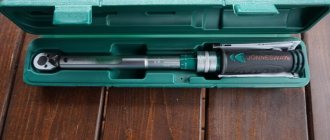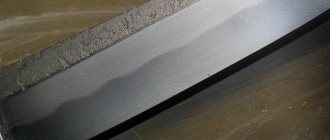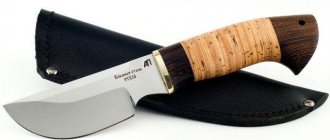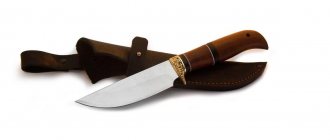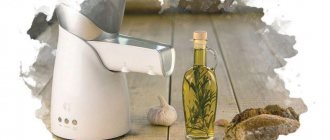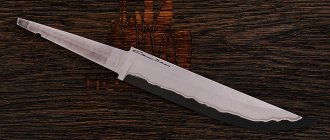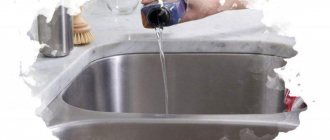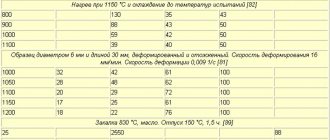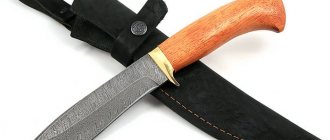Bearing steel ШХ15
The development of metallurgy has led to the emergence of steels with special performance characteristics. They are used in the manufacture of certain products that must have special qualities. An example is bearing steel ShKh15, which can withstand high temperatures well. The GOST standard for ShH15 determines the use of certain standards for marking.
Carbon steel ШХ15
Basic properties of steel
In industry, ball bearing steel ШХ 15 is widely used. This is due to the special performance characteristics that allow the use of metal in the creation of bearings and blades. The name steel comes from the fact that almost all bearings are made using this material.
The characteristics of steel ШХ15 are as follows:
- Increased surface hardness. The bearings and cutting edge of the blade are subject to wear during operation. To ensure that the surface of the product does not react to mechanical stress, the hardness index increases significantly.
- Wear resistance determines that the surface does not react to friction and other impacts. Metal ШХ9 and ШХ15 are characterized by high wear resistance, so the created products can last for a long period.
- Corrosion resistance can also be called an attractive quality of the metal in question. Rust that appears on the surface reduces the service life of the product. ShKh15 steel does not belong to stainless steel. Therefore, one should not count on high resistance to high humidity and chemically aggressive environments.
- Resistance to crushing. Point exposure to high loads can lead to the formation of a dent, but the metal in question is characterized by high resistance to such effects.
- Plasticity and viscosity are also taken into account when creating various products.
- The structure lends itself perfectly to heat treatment. As a rule, hardening is carried out after giving the required shape and size. In addition to hardening, annealing and forging are performed, which can also improve the structure of the material.
- The tendency to temper brittleness determines that structural defects may appear after hardening. They can increase the fragility of the resulting product.
- Poor weldability. They were able to increase the hardness by increasing the carbon concentration. However, this chemical element significantly complicates the welding process. As a rule, to improve the quality of the weld, the workpiece is heated.
Properties of bearing steel ШХ 15
Steel grade ShKh15, which is deciphered in accordance with established GOST standards, lends itself well to various types of processing and is resistant to crushing. In addition, the surface is characterized by high hardness. The temperature of the critical points is quite high; it is taken into account when carrying out heat treatment.
Download GOST 801-78
Decoding steel
- Ш - ball bearing steel;
- X - the presence of the alloying element chromium in a volume of no more than 1.5%.
Chemical composition and structure
The steel grade in question, ShKh15, has an unusual composition, which determines its special performance characteristics. The grade belongs to low-alloy chromium steels. This determines that the composition contains a large number of special additives, which impart strength, durability and corrosion resistance. The composition includes the following elements:
- A high concentration of carbon determines increased hardness of the structure. The carbon concentration indicator is 0.95-1%.
- Manganese is included in the composition of almost any steel. In the case under consideration, the concentration is 0.2-0.4%.
- Silicon increases the strength and other characteristics of the material. SHH 15 has an indicator in the range from 0.17-0.37%.
- In most cases, corrosion resistance is achieved by adding large amounts of chromium. ShKh 15 is characterized by low resistance to aggressive chemicals and moisture, since the composition contains only 1.35-1.65% chromium.
Microstructure of Shx15 after quenching in oil
A small amount of chromium determines that it does not form its own carbides, remains in solid solution and can be part of cementite. The structure is characterized by homogeneity with small carbides. It is this property that leads to increased wear resistance.
Processing Features
Today, heat treatment is carried out to increase the basic qualities of the metal quite often. Among the features we note:
- ShKh15 is hardened quite often. It allows you to significantly increase the hardness of the surface layer. It is worth considering that after hardening it is quite difficult to sharpen the cutting edge. Hardened steel ShKh 15 is difficult to process by cutting. That is why hardening is carried out after giving the workpiece the required shape and size. Heat treatment modes largely depend on the temperature of critical points. It is worth considering that cooling in water leads to the formation of structural and surface deformations. Cooling in the open air is carried out only in case of large product sizes.
- Annealing of ShKh15 steel is carried out at a temperature of about 800 degrees Celsius. This treatment eliminates internal stresses that cause cracks and other defects. As a rule, annealing is carried out after hardening the product. To carry out such a process, various equipment can be used.
- The workpiece can also be forged, for which it is heated to 1150 degrees Celsius. Cooling is carried out outdoors or in a pit. When forging, the structure of the material becomes more dense and resistant to various impacts.
When considering the main qualities, the tendency to temper brittleness is taken into account, as well as the ability to carry out cutting processing. A variety of equipment can be used for heat treatment. The high melting point means that improvement is extremely rare at home.
Areas of application
The use of ShKh15 steel is largely due to the high hardness and strength of the structure, as well as insignificant corrosion resistance and wear resistance. The alloy is used to obtain:
- Balls used in the manufacture of bearings. During the operation of bearings, this element is subjected to strong mechanical stress. Therefore, special attention is paid to their production; the product is often hardened.
- Rollers with a diameter of up to 23 mm. Roller bearings that are designed for heavy loads are also available for sale.
- Plungers.
- Discharge valves. They are also subject to significant impacts at the time of operation.
- Push rollers.
Steel ball for bearing ШХ-15
The fact that the ShKh 15 alloy is called a bearing alloy determines its use in the creation of such products. They can withstand long-term use, withstand friction and other mechanical stress, and high temperature.
Knives made of steel ШХ15
ShKh15 steel is characterized by versatility in use. It is used to produce a wide variety of knives, like the ShKh16 alloy. Today the brand is considered one of the most popular, which is due to its low cost. The ShKh15 knife is characterized by the following qualities:
- The blade lasts for a long period. Good wear resistance means that the cutting edge does not need to be sharpened frequently.
- The cutting edge holds its edge for a long time.
- The surface cannot be sharpened. Therefore, after its loss, it is quite difficult to restore it.
- The cutting edge is not exposed to moisture and various chemical elements. Over a long period, no rust or oxidation appears on the surface.
- The resulting blade is not brittle, the surface is hard. That is why the scope of application of the knife is expanding significantly.
ShKh15 steel is used to create products that are used under the most severe conditions. However, the material is not universal, which is due to its relatively low corrosion resistance.
Characteristics of bearing alloys
Ball bearing steel, which is used for the manufacture of rolling bearings, regularly experiences alternating loads. Repeated pressure on any area of the roller rings or balls causes the creation of local stress.
The stress can periodically reach 500 kgf/cm2, which can cause minor deformation of the rolling product. At first glance, it may seem that nothing bad has happened, but since stress regularly affects the bearing, after some time cracks appear on it.
Also, during operation, bearings wear out significantly, so areas with abrasion appear on them. Wear is caused by stress and friction during operation. During operation, small particles may break off, acting as an abrasive, which leads to premature wear due to abrasion.
The abrasion factors of a part are influenced by the following factors:
- chemical characteristics of the environment where the part is used;
- build quality of the product itself;
- the number of abrasive particles in the product.
If a part is operated in a very active mode, then structural elements can wear out much earlier than failure occurs due to fatigue deformation. If combined loads are placed on the bearings, the service life of the steel will be significantly reduced.
Since all elements are constantly in direct contact with each other, a prerequisite for the production of bearing steels is the exclusion of foreign impurities from their composition
It is important that the alloy is homogeneous, since small changes in the material will cause cracks and other damage to occur during operation. All bearing steels must have low brittleness and high fatigue resistance in metal alloys
Also, based on the scope of application, alloys must be resistant to mechanical wear and characterized by strength.
Steel ШХ15: characteristics, application, properties, explanation of markings
The characteristics of the use of ShKh15 steel, as well as the process of its production, led to the fact that it began to be classified as a structural steel.
Steel structure
The most important requirement for this type of steel is high hardness. In order to achieve this indicator, a large amount of carbon is used as an alloying element, and a certain amount of chromium is also added.
At the time of delivery of this steel, its structure is a ferrite-carbide mixture. Most often, when this type is supplied, it is written that it is annealed to granular perlite.
It is also important to note that the characteristics of the use of ShKh15 steel include high ductility, which must be observed, since raw materials of this grade are often used for the production of various plastic structures.
The steel hardening temperature at which it undergoes heat treatment is 830-840 degrees Celsius. The release of raw materials is carried out at a temperature of 150 to 160 degrees, and the time required to complete the operation is 1-2 hours.
Carbide phase
Further characteristics of the use of ShKh15 steel largely depend on the carbide phase and its successful completion. If we examine its progress under a microscope, we can observe that upon successful completion, the force required to destroy the matrix is 140 kN.
In order to achieve such an indicator, the ball, which is the main element of the structure, must have a homogeneous matrix, as well as sufficiently homogeneous carbides. They must be identical both in size and in their distribution in the matrix.
If something goes wrong during processing, the force required to destroy the structure can drop to 68 kN. If this happens, it means that the structure of the ball is heterogeneous. The carbides in this case may be unevenly distributed and/or of unequal size.
This indicator is very significant for steel.
Carbide phase defects
Since the characteristics of the use of ShKh15 steel largely depend on the flow of the carbide phase, it is important to know what defects this process may have:
- One of the first defects is carbide banding. It occurs due to the fact that there is heterogeneity in the structure of the steel after hardening. In those areas where a large amount of carbides is present, a martensite-troostite structure appears, and in those areas where the amount of this substance is small, acicular martensite appears.
- Another defect that can occur is carbide segregation. In bearing type steel, large inclusions of carbides are often found, which are located along the rolling direction - this is called carbide segregation. The defect of this phenomenon is that these elements are characterized by high strength, but also high fragility. Most often, such elements are destroyed when steel reaches the working surface, which creates a source of destruction. A pronounced defect of this type greatly increases the wear of ball bearing steel.
Due to the application characteristics of ShKh15 steel, it is often used for the production of balls, rollers and bearing rings.
It is worth noting that during operation of these parts they are constantly exposed to high alternating stresses.
It is also important to understand that the roller or ball, as well as the track of rings, experience a high load at a single moment in time, which is distributed over a very small area of the plane.
Because of this, alternating stresses of the order of 3-5 MN/m2 (300-500 kgf/cm2) alternately arise in such areas.
It is because of such loads that the hardening temperature of the steel is very high in order to impart high strength to the material. It is also important to note that such high loads do not pass without leaving a trace; they leave a slight deformation of the bearing elements.
Because of this, fatigue cracks form on the bearing.
The appearance of these defects leads to the fact that when passing through this section, an impact occurs, due to which the deformation only intensifies, and ultimately the bearing completely fails.
Bearing steel: characteristics
This grade of steel is used for the production of balls with a diameter of up to 150 mm, rollers with a diameter of up to 23 mm, as well as for the production of bearing rings with a wall thickness of 14 mm.
This steel can also be used for the manufacture of plunger bushings, injection valves, and other parts for which the main requirement is high hardness, high wear resistance, and contact strength.
Bearing steel of this grade also has a number of certain characteristics, such as: a tendency to temper brittleness or flake sensitivity. The short-term strength limits of this material are in the range from 590 to 750 MPa.
The proportionality limit for this material is 370-410 MPa. The relative elongation of the material at break is 20%. Steel grade ШХ15 has a relative narrowing of 45%.
In addition, there is also an impact strength characteristic, the value of which is 440 kJ/m2.
Properties of steel ШХ15
If we talk about the properties of this brand, then you need to pay attention to its chemical composition, which largely affects the formation of these properties. ShKh15 steel contains the following chemical elements:
- C – 0.95 -1.0;
- Si – 0.17-0.37;
- Mn – 0.2-0.4;
- Cr – 1.35-1.65.
This brand is also characterized by another parameter - the critical temperature point. For steel ШХ15 this figure is in the range from 735 to 765 degrees Celsius.
In order to achieve the required strength, this type of alloy is subjected to intense heating, the temperature of which exceeds the eutectoid transformation. It provides the required concentration of elements such as C and Cr in the steel composition in solid form, and also creates a fine, homogeneous grain structure.
The interpretation of steel ШХ15, which is obtained as a result of all these operations, is as follows: the letter Ш indicates that the material belongs to the group of bearing steels, and the letter X indicates that the raw material contains a material such as chromium, which is one of the alloyed elements.
Carbon steel
ShKh15 steel is a carbon and low-alloy steel, which in the manufacture of knives has acquired the name “carbon”. This material has been used for approximately 100 years. The main area of application of this material is bearing, wear-resistant and cutting parts or elements.
It is also worth noting that this group of steel is classic for making knives abroad. A knife made from ShKh15 will have enormous strength, as well as significant sharpness. Such products are most often used for any cutting tools, but ordinary kitchen knives can also be made from it.
Features of use
The interpretation of steel ШХ15 speaks for itself, but it is worth adding that 15 is an indicator of the amount of chromium in the material, which is contained there in the amount of 1.5%.
When operating products made from this steel in a metastable environment with high loads, geometric changes in the dimensions of the part are quite possible.
After observing hardened samples and their changes in size, as well as after conducting x-ray studies, people found that in order to stabilize a substance such as martensite, it is necessary to harden the raw material for 2-4 hours at a temperature of 150 degrees Celsius.
If it is necessary to stabilize martensite for further operation of the substance at elevated temperature conditions, then the tempering process must take place at a temperature threshold that will exceed the operating temperature by 50-100 degrees Celsius.
It can be noted that the main reason why, after quenching and tempering, steel changes its geometric parameters is the influence of retained austenite.
To give a clear example, we can imagine the following statement: 1% of authensite, when transformed into martensite, will change the size of the part by 1•10-4.
For a clearer definition, this means that the size change will occur by 10 microns for every 100 mm of size.
Application
ШХ15 is used in the bearing industry. It is used to make balls with a maximum size of 150 mm, and rollers with a maximum size of up to 23 mm. In addition, bearing rings whose thickness does not exceed 14 mm are produced from ShKh15 steel.
During operation, bearing parts are subjected to large loads distributed over a small area. Moreover, these loads have different polarities, such loads are called alternating loads, they can reach pressures of the order of 300 - 500 kg/sq. cm. That is why the heat treatment of this steel takes place at high temperatures.
It is important to understand that such loads cannot pass without leaving a trace and sooner or later microcracks may form on the inner surface of the rings. The appearance of defective areas leads to an increase in shock load, which, in turn, leads to an increase in defective areas, resulting in bearing failure.
This material has been used in industry for about 100 years; in addition to the bearing industry, this material is used for the production of cutting tools, including knives. A knife made of steel has a large margin of strength and the ability to maintain an edge for a long time. The characteristics of the material make it possible to produce basic kitchen knives.
Structural bearing steel ШХ15
Rolled metal calculator How to order?
Brand ШХ15 – purpose
Structural bearing steel ШХ15 is used for the manufacture of parts with high contact strength/hardness/wear resistance - balls Ø up to 150 mm, rollers Ø up to 23 mm, rings with wall thickness up to 14 mm, pusher rollers, nozzle bodies, discharge valves, plungers and bushings, other products.
Steel ШХ15 – domestic analogues
| Rolled metal grade | Substitute |
| ШХ15 | ШХ9 |
| ШХ12 | |
| SHH15SG |
Material ШХ15 - characteristics
| Brand | Classification | Type of delivery | GOST | Foreign analogues |
| ШХ15 (ШХ15–В, ШХ15–Ш) | Structural bearing steel | Long products | 801–78 | There is |
Heat treatment
| Mode | Cooling medium | t, 0С |
| Annealing | oven, 150S/h | 800 |
Forging
| Type of semi-finished product | t, 0С | Cooling | |
| Size | Conditions | ||
| Ingot | 1150–800 | up to 400 | Low temperature annealing |
| Blank | up to 250 | On air | |
| 251–350 | In the hole |
Welding
| Weldability | Welding methods |
| difficult to weld | KTS |
cutting
| Initial data | Machinability Ku | |||
| State | HB, MPa | sB, MPa | hard alloy | high speed steel |
| annealed | 179–217 | 730 | 0.90 | 0,36 |
Steel ШХ15 – chemical composition
Mass fraction of elements no more than, %:
| Oxygen | Silicon | Manganese | Copper | Nickel | Sulfur | Titanium | Carbon | Phosphorus | Chromium |
| 0,0015 | 0,17–0,37 | 0,2–0,4 | 0,25 | 0,3 | 0,02 | 0,01 | 0,95–1,05 | 0,027 | 1,3–1,65 |
Material ШХ15 – mechanical properties
| Assortment | GOST | Dimensions – thickness, diameter | Heat treatment mode | t | KCU | y | d5 | st | sв |
| mm | 0C | kJ/m2 | % | % | MPa | MPa | |||
| Rental | 801–78 | Annealing (furnace) 150S/h | 800 | 440 | 45 | 20 | 370–410 | 590–730 |
Hardness, MPa
| Assortment | GOST | HB 10-1 |
| Rental | 801–78 | 179–207 |
Temperature of critical points, 0С
| Critical points | Ac1 | Ac3 | Ar1 | Ar3 | MP |
| Temperature | 724 | 900 | 700 | 713 | 210 |
Impact strength, J/cm2
| Heat treatment | KCU at temperatures | ||||
| -500С | -400С | -250С | -200С | 00С | +200С |
| Quenching (oil) 8300C | 64 | 69 | 88 | ||
| Vacation (air) 1500С |
Endurance limit, MPa
| Heat treatment | H.R.C. | NV | t-1 | s-1 |
| Annealing | 192 | 333 | ||
| Quenching (oil) 8300C | 60 | 804 | ||
| Holiday 1500С |
Brand ШХ15 – physical properties
| t | r | R 109 | E 10-5 | l | a 106 | C |
| 0C | kg/m3 | Ohm m | MPa | W/(m deg) | 1/Grad | J/ (kg deg) |
| 20 | 7812 | 2.11 | ||||
| 100 | 7790 | 390 | 11.9 | |||
| 200 | 7750 | 470 | 40 | 15.1 | ||
| 300 | 7720 | 520 | 15.5 | |||
| 400 | 7680 | 37 | 15.6 | |||
| 500 | 7640 | 32 | 15.7 |
Steel ШХ15 – exact and closest foreign analogues
| Australia | England | Bulgaria | Hungary | Germany | European Union | Spain | Italy |
| AS | B.S. | BDS | MSZ | DIN, WNR | EN | UNE | UNI |
| 100Cr6 | |||||||
| 102Cr6 |
| China | Poland | Romania | USA | France | Czech | Sweden | South Korea | Japan |
| G.B. | PN | STAS | – | AFNOR | CSN | SS | KS | JIS |
Material ShKh15 – area of application
ShKh15 grade steel is used for the manufacture of parts with high contact strength/hardness/wear resistance.
Mechanical properties
| HRСе | HB | KCU | y | d5 | sT | sв |
| MPa | kJ/m2 | % | % | MPa | MPa | |
| Rockwell hardness | Brinell hardness | Impact strength | Relative narrowing | Elongation at break | Yield strength | Short-term strength limit |
| Ku | s0.2 | t-1 | s-1 |
| Relative machinability factor | Proof of yield strength with 0.2% tolerance when loaded to plastic strain value | Torsional endurance limit (symmetrical cycle) | Endurance limit under compression-tension (symmetrical cycle) |
| N | number of deformation/stress cycles sustained by an object under load before fatigue failure/crack appears |
Weldability
| No limits | Limited | Difficult to weld | |
| Heating | No | up to 100–1200С | 200–3000С |
| Heat treatment | No | There is | annealing |
Physical properties
| R | Ohm m | Resistivity |
| r | kg/m3 | Density |
| C | J/(kg deg) | Specific heat |
| l | W/(m deg) | Coefficient of thermal conductivity |
| a | 1/Grad | Linear expansion coefficient |
| E | MPa | Elastic modulus |
| t | 0C | Temperature |
You can buy structural bearing steel ШХ15 in St. Petersburg by calling +. Specialists will place your order and advise you on the assortment, prices, and delivery conditions.
Attention! All emails and invoices from Lenspetsstal LLC are sent only from the mail domain @lsst.ru Documents sent from other addresses are invalid!
Electronic document management – EDI. A secure way to transfer documents, quickly, conveniently, an archive of all files, a modern solution for accounting and supply. We work with Kontur.Diadoc and VLSI, join us!
Steel ШХ15
The development of metallurgy has led to the emergence of new types of steels with special performance characteristics. They are used in the production of certain products and parts that have high demands. A similar example is steel ШХ15. Its main purpose is the manufacture of bearings, but its performance indicators are also actively used in knife production.
Steel strips ШХ15.
Steel for quality knives
ShKh15 was first created as a production tool steel, but over time it gained greater versatility and turned into one of the best alloys for making knives.
The metal lends itself well to heat treatment, which allows it to be actively used in the production of cutting tools. After heat treatment, the strength and wear resistance of knives increases significantly.
Blades made of ШХ15 have a long service life , since resistance to external loads allows them to hold an edge for a long time. They withstand the influence of the external environment well.
Blade made of steel ШХ15.
ShKh15 steel for knives is used in the production of tactical, gift, hunting and kitchen models.
Such products cope with cutting meat, chopping bones and branches, cutting thick ropes, and all household tasks without any problems. This knife will be a godsend for an avid cook.
And if you carefully monitor and care for your instrument, it will last a long time.
Characteristic
ShKh15 steel received its wide industrial distribution due to its special performance properties, which are ideal for the manufacture of blades and bearings. Characteristics of ШХ15 consists of the following parameters:
- High hardness index . Bearings and blades are subjected to high loads during use, resulting in rapid wear. To prevent this from happening, the product must have additional hardness.
- Wear resistance , that is, the surface of ShKh15 is not subject to abrasion, which allows it to maintain its original working properties for a long time.
- Poor resistance to corrosion . Due to the small content of such an important element as chromium in the chemical composition, this alloy rusts when exposed to moisture, but this process does not occur very quickly due to other alloying components.
- Resistance to high shock and external mechanical loads . This metal practically does not form dents from precise impacts.
- Plasticity and toughness in the alloy in question are at an average level due to its high hardness.
- The steel structure lends itself well to heat treatment . Quenching and annealing make it possible to improve strength at the molecular level.
- Tendency to temper brittleness, which means that there is a small chance that the metal may become more brittle after quenching due to structural defects. But strict adherence to all technologies allows you to avoid this.
- Poor weldability . The alloy achieves high hardness due to its high carbon content, an element that negatively affects weldability.
pros
Having studied in detail the characteristics of steel grade ШХ15, we can draw intermediate results. Among the advantages of this alloy, the following qualities clearly stand out:
- homogeneity of structure;
- high contact endurance;
- easy to process;
- great hardness;
- excellent wear resistance;
- thin edge when sharpening;
- resistance to crushing;
- plasticity and viscosity.
Minuses
Any steel, no matter how good it is, has drawbacks - it has not yet been possible to obtain a metal that is ideal in all respects. However, the disadvantages of the ShKh15 are not numerous, among them the following can be distinguished:
- above average fragility;
- relatively low corrosion resistance;
- Difficult sharpening of cutting tools.
There are many different grades of steel. Each of them has its own advantages and disadvantages. ShKh 15, in turn, is a very versatile steel, suitable for almost any type of knife. At the moment it is one of the most popular brands with low cost and is used mainly in private forging of blades.
Knife Berkut, steel ШХ15, oxidation coating.
Chemical composition
ShKh15 steel has an unusual chemical composition , which determines its working properties. This brand belongs to low-alloy chromium alloys, which is due to a large number of base additives, which impart the same strength and wear resistance. The composition includes the following elements:
- Carbon (0.95-1%) – its fairly high concentration allows one to achieve increased hardness of the structure.
- Manganese (0.2-0.4%) is present in almost all steels. It is used to remove oxygen and sulfur from steel. It also has a beneficial effect on the ductility and weldability of steels.
- Silicon (0.17-0.37%) - used in steel smelting, has a positive effect on strength and improves the effect of other components. In combination with manganese or molybdenum, silicon provides higher hardenability of steel.
- Chromium (1.35-1.65%) – chromium ensures the alloy’s resistance to rust, but only if its content exceeds 13%. Therefore, ШХ15 is characterized by low corrosion resistance. A small amount of chromium determines that it does not form its own carbides, remains in solid solution and can be part of cementite. The structure is characterized by homogeneity with small carbides. It is this property that leads to increased wear resistance.
Decoding
At first glance, it may seem that the name of the alloy “ShKh15” is a simple set of beech. However, this is not at all true; these letters are abbreviation symbols and carry a semantic load. A person who knows at least a little about metal markings can extract some useful information from this name:
- Ш - according to GOST, all bearing steels are marked with this letter;
- X – means the presence of chromium in the chemical composition of steel;
- 15 – this is the percentage of chromium (1.5%).
GOST
State standards regulate the production stages, characteristics, properties of all steels, ShKh15 is no exception. All detailed information about bearing steels is contained in GOST 801-78.
The permissible limit of elements in the chemical composition, correct hardening, correct labeling, application, etc. are indicated here. Also, for each individual product for the production of which ShKh15 is used, it has its own GOST.
Types of material supply:
| B22 – Long and shaped rolled products | GOST 2590-2006; GOST 2591-2006; |
| B23 – Sheets and strips | GOST 103-2006; |
| B32 – Long and shaped rolled products | GOST 14955-77; GOST 7417-75; GOST 801-78; |
| B62 – Steel pipes and connecting parts for them | GOST 800-78; |
| B73 – Alloy steel wire | GOST 4727-83; |
Specifications
The working properties of ShKh15 steel have already been discussed above. That information is a simple explanation that follows from the following characteristics of this alloy:
- brand: ШХ15;
- class: structural bearing steel;
- specific gravity : 7812 kg/m3
- heat treatment: annealing 800oC, oven, 15 oC/h;
- forging temperature, °C: beginning 1150, end 800. Sections up to 250 mm are cooled in air, 251-350 mm - in a pit;
- hardness : HB 10 -1 = 179 – 207 MPa (61-63 HRC);
- temperature of critical points: Ac1 = 724, Ac3(Acm) = 900, Ar3(Arcm) = 713, Ar1 = 700, Mn = 210;
- machinability by cutting: in the hot-woven state at HB 202 σв=740 MPa, K υ solid. spl=0.9 and Kυ b.st=0.36;
- weldability: welding method KTS;
- flake sensitivity: sensitive;
- tendency to temper brittleness : prone;
- grindability: good.
Analogs
ШХ15 has a large number of analogues around the world . This is due to the fact that bearing steels are subject to the same requirements.
The result is a similar chemical composition, production technology, and characteristics.
Below is a table with similar alloys from different countries of the world, but it is worth considering that their properties, and even more so their cost, are not identical, but simply have many similarities.
| Foreign analogues of steel grade ШХ15 | |
| USA | 52100, G52986, J19965 |
| Germany | 1.3505, 100Cr6, 102Cr6 |
| Japan | SUJ2, SUJ4 |
| France | 100C6, 100Cr6, 100Cr6RR |
| England | 2S135, 534A99, 535A99 |
| China | GCr15 |
Application
The use of ShKh15 is largely due to its high strength indicators and wear resistance - the main advantages of this brand. The scope of application is quite wide , the alloy is used to obtain:
- rollers with a diameter of up to 23 mm;
- discharge valves;
- pusher rollers;
- plungers;
- balls for bearings.
Bearings made of steel ШХ15.
Although this steel is defined as bearing steel, its use is not limited to this. It is actively used in the production of knives and other cutting tools because it has the necessary basic set of useful qualities.
Owner reviews
PreviousNext
Steel ШХ15 – characteristics and application
There is probably no mechanism or machine that does not use bearings. For their production, steels with special parameters are used, these include the characteristics of ShKh15 steel.
Steel ШХ15 and knives
There are many grades of steel in the world. Only one brand of steels and alloys mentions about 600 items. Each has certain qualities that allow it to be used in various industries. Brand ШХ15 is a universal material that can be used to make any type of knives.
Today, this is one of the most popular varieties, which has a relatively low price and is used in the manufacture of blades.
ShKh15 is a representative of the group of low-alloy chromium steels. The names of alloying elements and their percentage composition are indicated above. This steel contains a relatively small amount of chromium. This is the reason why chromium carbides do not form in the alloy structure.
Chromium in this case is in solid solution and in cementite. This is precisely the basis for the high endurance of this steel. And for the same reason, a blade made from the ShKh15 brand can hold its edge for a long time.
The parameters of the steel provide the blades with resistance to wear, the necessary hardness, and strength.
One of the reasons that this grade of steel has become popular among knife manufacturers is its relatively easy processing when heated. In this case, the blade not only receives the necessary shape, but also significantly increases its strength characteristics. The high hardness of the steel provides excellent wear resistance. In addition, it should be noted that the blade is difficult to jam.
To obtain optimal properties of the ShKh15 alloy, it is heat treated. The optimal hardening temperature is 810 – 850 ºC. Tempering is carried out in the temperature range from 150 to 160 ºC. After performing these operations, the hardness of the material reaches 61 - 64 HRC.
The higher the accuracy class the better
If the bearing is not intended for installation on precision equipment, then the accuracy class is not of fundamental importance.
Machining quality with an accuracy of several microns is simply necessary for high-speed components, and is not at all required for most industrial units. High-precision bearings cannot be replaced by units of a lower class of processing cleanliness - such an improvement will affect the deterioration of the equipment’s performance, even to the point of failure.
Replacing conventional bearings with high-precision ones does not make sense - an expensive precision bearing will not significantly improve the operation of the unit.
Photo: bestbearing.com.ua
ShKh15 steel for knives: pros, cons and its characteristics
Each type of steel has its own properties and characteristics, positive and negative sides, which are used in the production of knives for various purposes. ShKh15 steel is one of those that is used for the manufacture of knives and other cutting tools. Refers to carbon low-alloy chromium alloys.
Initially, ShKh15 metal was intended for the production of rollers and balls for bearings due to its increased hardness, wear resistance and corrosion resistance. That’s why steel was called bearing steel, although in Europe craftsmen widely used it to make knives.
The feasibility of its use was due to its high wear resistance, hardness and so-called contact strength. Simply put, when working with very strong materials for a long time, the product does not deform and retains its structure and properties, does not break, does not crumble into crumbs.
Its Russian analogues and substitutes are steel grades ШХ9, ШХ12, ШХ15СГ. The alloy is also widely used abroad, but is used mainly for the manufacture of household cutting tools.
Alloys of similar or similar composition are produced in the USA, European Union countries, Australia, South Korea, and China.
Properties of steel alloys
Based on the name, you can immediately guess that bearing steel grades are needed for the production of balls for bearings, rings, rollers and other various parts that are subject to increased load.
Steels with increased carbon content:
- Alloys intended for use at high temperatures and aggressive environments. Such steels are subject to increased demands, so they must be resistant to heat and corrosion.
- Steel alloys for operation under standard conditions. Metal can be used in various industries. The alloys contain chromium-manganese, chromium, molybdenum, and silicon.
Popular bearing alloys include the following grades of steel: 11Х18М-ШД, ШХ15, 95Х18-Ш, ШХ20СГ, 8Х4М4ВФ1-Ш. The letters ШД in the marking of a steel alloy means that the steel was produced using vacuum-arc processing. The letter Ш means that electroslag technology was used in the production of these alloys.
The main characteristics of metal alloys are very similar to the chemical composition of steel from the tool group.

